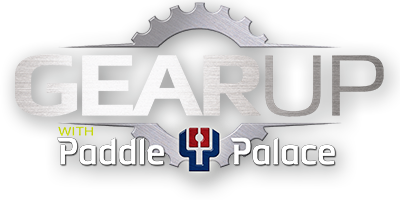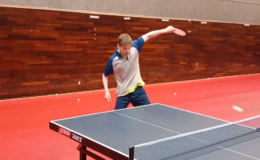By Larry Hodges, USATT Hall of Famer and Certified National Coach
How high should you toss the ball when you serve? At all levels there’s a huge range, from tosses that challenge the six-inch rule to ones that go up to the rafters. And yet most top players toss the ball up to perhaps head-high. What are the advantages of these different tosses, and how high should you toss?
Let’s start with the rules. You must throw the ball up at least six inches (that’s the height of the net for perspective), and contact it on the drop. There’s no limit to how high you can toss it.
You can divide tosses into three types: very short tosses, medium-high tosses (the most common), and high tosses.
The purpose of a short-toss serve is to rush the opponent. So these serves should be as short as possible, probably in the 7″-8″ range, and often challenging the 6″ rule. Many players push this to the limit, and often toss it up less than six inches. (If you do, prepare to be faulted on it sometimes, and for opponents to complain. Ideally, learn to consistently toss it just over six inches.) Short-toss serves are usually done on backhand serves (since higher tosses are tricky to control on that side), though it can be done on other serves. Ironically, since players are so used to higher tosses on forehand serves, a short-toss on that side often appears lower than the same serve on the backhand side, and so a short toss on the forehand side is more likely to rush an opponent – or to have him (often erroneously) complain that the toss is too low. Another advantage of a short-toss serve is the ball is traveling slower at contact, giving great control, especially on height and depth, once the server masters the faster timing required. The disadvantage of a short-toss serve: the server is somewhat rushed.
The purpose of a high-toss serve is to maximize spin as well as throw off the opponent’s timing. By throwing the ball high into the air it maximizes the speed of the dropping ball. A good server can use this to increase spin. To do so, he must still accelerate his racket into the ball at full speed and just graze the ball – not an easy thing to do with a fast-dropping ball. Below the elite levels most high-toss serves are more for show than actually improving the serve – the player often simply doesn’t yet have the timing or skill to graze the ball; it takes lots of practice. (But it might still be a good variation if not overused.) By throwing the ball high into the air you also throw off the opponent’s timing as he has to stand there, waiting for the ball to come down. It also means he may take his eye off your racket as he watches the ball, and so miss the actual contact when the ball finally reaches it. (Suggestion for receivers – watch the ball only far enough up so as to see how high it’ll go, then focus on the server’s racket so you don’t miss contact.) You can actually divide high-toss serves into two types – high tosses, and super-high tosses. Some throw the ball up perhaps five feet over their head; some throw the ball high up into the rafters, making the receivers crane their necks to follow it. The disadvantage of a high-toss serve: loss of control on spin, speed, height, and depth.
The purpose of a medium-high serve is to maximize control. This means tossing the ball perhaps up to perhaps eye level or just above. This allows the server to serve without rushing, and maximizes the overall control of spin, speed, height, and depth. At higher levels, where depth control is so important, this is the most common serve. (Why is depth so important at the higher levels? Because they usually want the serve to be as deep as possible and still be “short,” i.e. second bounce right at the end line, or the related version where the second bounce is just barely past the end line.) Another advantage of a medium-high toss is that it allows you more time to do deceptive motions as the ball reaches the contact point. With a short toss, you don’t have as much time to do this; with a high-toss serve, the ball goes by so fast you also don’t have as much time to do this. With a medium toss, you can do all sorts of racket movements as the ball goes by to deceive your opponent. The disadvantage of a medium-high toss serve is you aren’t rushing your opponent, nor are you throwing off his timing or maximizing spin.
My recommendation is to focus on medium-high tosses at first, until you have great spin on your serves as well as excellent control. Then you can begin experimenting with shorter and higher tosses. By varying the height of your toss, you can throw off an opponent’s timing. At the higher levels, high-toss serves are especially effective, but don’t make the mistake of doing them for show; learn to do them effectively. And that takes lots and lots of practice. As do all great serves.



